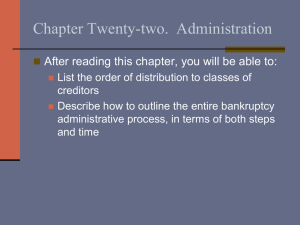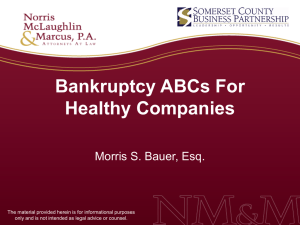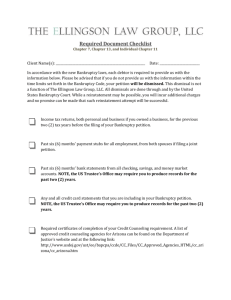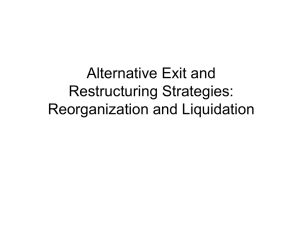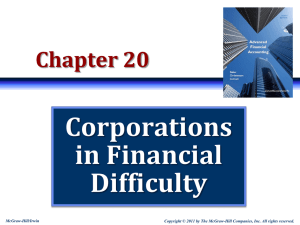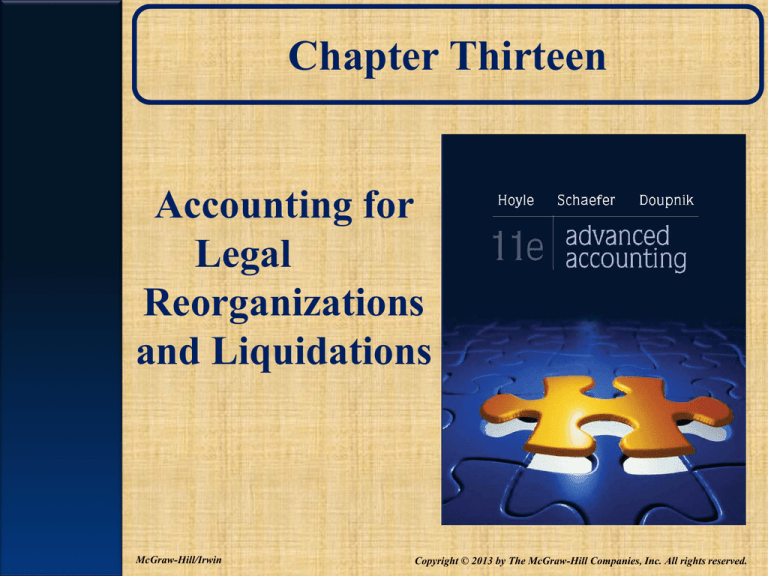
Chapter Thirteen
Accounting for
Legal
Reorganizations
and Liquidations
McGraw-Hill/Irwin
Copyright © 2013 by The McGraw-Hill Companies, Inc. All rights reserved.
LO 1
Bankruptcy
A basic assumption of accounting is
that a business is a going concern (will
remain in business).
Occasionally, a business becomes
insolvent (unable to pay debts as they
come due).
An insolvent business can either cease
to exist, or can seek a legal remedy
called bankruptcy.
13-2
LO 2
Bankruptcy Reform Act of 1978
Involuntary Bankruptcy
Voluntary Bankruptcy
Creditors file
petition with the
court.
Company files a petition
with courts requesting
bankruptcy.
Can force company
into liquidation
under Chapter 7 or
receiving
protection under
Chapter 11.
When facing prospect of
severe losses or a
difficult operating
environment, companies
will seek voluntary
Chapter 11.
13-3
Criteria for Forcing
Involuntary Bankruptcy
When there are 12 or more unsecured
creditors:
At least 3 must sign the petition
Those that sign must have total unsecured
debts of at least $14,425
If there are fewer than 12:
Only 1 must sign
The minimum debt limit remains $14,425
(Debt limit balances are adjusted every
three years based on the Consumer Price
Index)
13-4
Court Response to the Petition
Neither a voluntary nor involuntary
petition automatically creates a
bankruptcy.
Bankruptcy Court may reject voluntary
petitions if the action is considered
detrimental to the creditors.
Bankruptcy Court may reject involuntary
petitions unless evidence indicates the
debtor’s inability to meet obligations as
they come due (slowness of payment is
NOT sufficient cause!!)
13-5
Court Response to the Petition
If the court accepts the petition, it grants
an order for relief.
The order for relief halts all actions
against the debtor.
The automatic stay prohibits creditors
from collecting debts without the court’s
permission
A trustee is appointed to oversee the
bankruptcy process.
13-6
LO 3
Classification of Creditors
Each level must be paid in full prior to making
distributions to the next level.
Top
Priority
Fully
Secured
Partially
Secured
Unsecured With
Priority
Unsecured
13-7
LO 4
Reorganization or Liquidation?
How will the debtor be discharged
from its obligations?
Under Chapter 7, the debtor’s assets will be
liquidated and the proceeds distributed to
creditors (based on their priority status) OR
Under Chapter 11, the debtor will be
permitted to reorganize and continue
operations.
(These “chapters” refer to the relevant
sections of the Bankruptcy Reform Act)
13-8
LO 5
Statement of Financial Affairs
Statement helps creditors decide between
reorganization and liquidation for debtor.
Assets labeled as:
Pledged with fully
secured creditors.
Pledged with partially
secured creditors.
Available for priority
liabilities and
unsecured creditors.
Debts labeled as:
Liabilities with
priority.
Fully secured
creditors.
Partially secured
creditors.
Unsecured creditors.
13-9
Liquidation –
Chapter 7 Bankruptcy
LO 6
1.
Interim Trustee is appointed by court.
Changes
locks, and secures assets and
records.
Posts notices that assets are in possession of
US trustee.
Compiles all financial records.
Obtains possession of all corporate records.
2. An advisory committee of 3 - 11 unsecured
creditors is appointed.
13-10
LO 7
Reorganization Chapter 11 Bankruptcy
A legal way to “salvage” a company
rather than liquidate it.
The company is temporarily
protected from its creditors.
Creditors are encouraged to
negotiate new terms with the
company.
13-11
LO 8
Financial Reporting
During Reorganization
FASB’s Accounting Standards
Codification Topic 852, Reorganizations,
requires financial statements be prepared
During the reorganization and
When entity emerges from reorganization.
Gains, losses, revenues and expenses of the
reorganization are reported separately.
Liabilities are restated.
Current versus noncurrent classification
not applicable.
13-12
LO 9
Fresh Start Reporting
When a company emerges from Chapter
11, GAAP permits fresh start reporting if
two conditions are met:
The reorganization (or market) value of the
assets are greater than the total of the
allowed claims as of the date of the order for
relief plus any subsequent liabilities.
The original owners are left with less than
50% of the voting stock.
13-13
Fresh Start Accounting
Fresh Start Accounting
Assets are restated to current market
value.
Liabilities are stated at the discounted
present value of future cash
payments.
Retained Earnings is set to zero.
Normally, APIC is adjusted to
balance.
13-14

